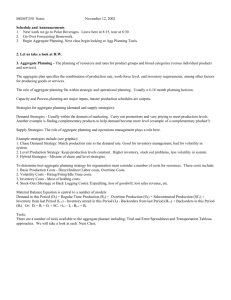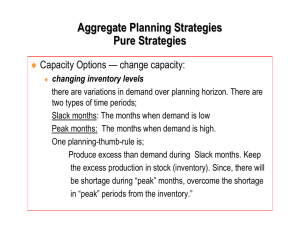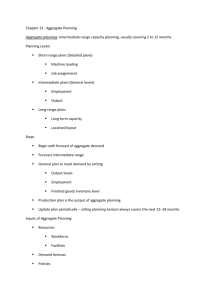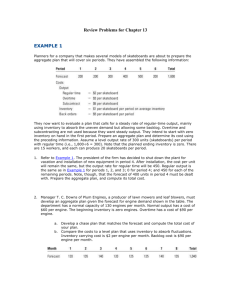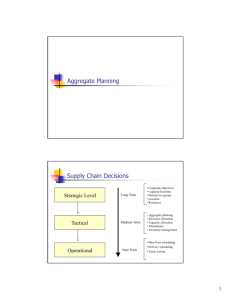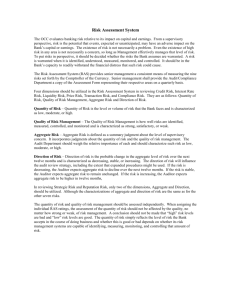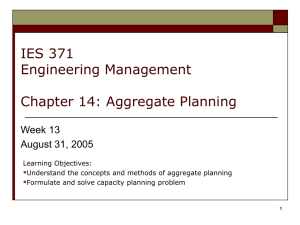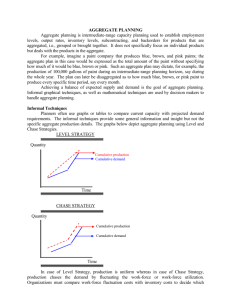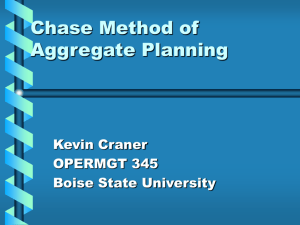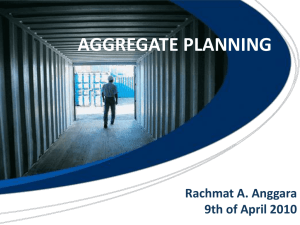Capacity Planning and Aggregate Production Planning
advertisement
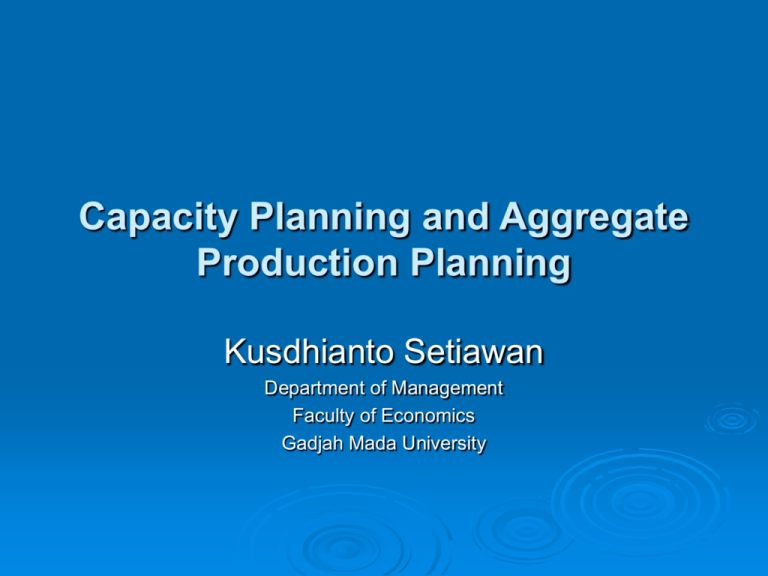
Capacity Planning and Aggregate Production Planning Kusdhianto Setiawan Department of Management Faculty of Economics Gadjah Mada University Capacity Planning Capacity planning is a long-term strategic decision that establishes a firm's overall level of resources. long time horizon: usually a year or more for building new facilities or acquiring new businesses. Capacity decisions affect product lead times, customer responsiveness, operating costs, and a firm's ability to compete. Inadequate capacity can lose customers and limit growth. Excess capacity can drain a company's resources and prevent investments in more lucrative ventures. When to increase capacity and how much to increase capacity are critical decisions. Strategy of Timing Capacity Expansion • Capacity lead strategy. Capacity is expanded in anticipation of demand growth. This aggressive strategy is used to lure customers from competitors who are capacity constrained or to gain a foothold in a rapidly expanding market. • Capacity lag strategy. Capacity is increased after an increase in demand has been documented. This conservative strategy produces a higher return on investment but may lose customers in the process. It is used in industries with standard products and cost-based or weak competition. The strategy assumes that lost customers will return from competitors after capacity has expanded. • Average capacity strategy. Capacity is expanded to coincide with average expected demand. This is a moderate strategy in which managers are certain they will be able to sell at least some portion of the additional output. • See Figure 11.1 Factors Affecting Capacity Expansion How much to increase capacity depends on the volume and certainty of anticipated demand; strategic objectives in terms of growth, customer service, and competition; and the costs of expansion and operation. Capacity can be increased incrementally or in one large step as shown in Figure 11.1(d). Incremental expansion is less risky but more costly. An attractive alternative to expanding capacity is outsourcing, in which suppliers absorb the risk of demand uncertainty. The Best Operating Level The best operating level for a facility is the percent of capacity utilization that minimizes average unit cost. Rarely is the best operating level at 100 percent of capacity--at higher levels of utilization, productivity slows and things start to go wrong. Average capacity utilization differs by industry. An industry with an 80 percent average utilization would have a 20 percent capacity cushion for unexpected surges in demand or temporary work stoppages. Large capacity cushions are common in industries where demand is highly variable, resource flexibility is low, and customer service is important. Utilities, for example, maintain a 20 percent capacity cushion. Capitalintensive industries with less flexibility and higher costs maintain cushions under 10 percent. Airlines maintain a negative cushion-overbooking is a common practice! See Figure 11.2 The Best Operating Level (cont’) High levels of output tend to cost less per unit. Called economies of scale, this holds true when: 1. Fixed costs can be spread over a larger number of units, 2. Production costs do not increase linearly with output levels, 3. Quantity discounts are available for material purchases, and 4. Production efficiency increases as workers gain experience. Economies of scale do not continue indefinitely. Above a certain level of output, diseconomies of scale can occur. Overtaxed machines and material handling equipment break down, service time slows, quality suffers requiring more rework, labor costs increase with overtime, and coordination and management activities become difficult. In addition, if customer preferences suddenly change, high-volume production can leave a firm with unusable inventory and excess capacity. Aggregate Production Planning Aggregate production planning (APP) determines the resource capacity a firm will need to meet its demand over an intermediate time horizon--six to twelve months in the future. Within this time frame, it is usually not feasible to increase capacity by building new facilities or purchasing new equipment; however, it is feasible to hire or lay off workers, increase or reduce the work week, add an extra shift, subcontract out work, use overtime, or build up and deplete inventory levels. APP Cont’ Scope: plans are developed for product lines or product families, rather than individual products. An aggregate production plan might specify how many bicycles are to be produced but would not identify them by color, size, tires, or type of brakes. Resource capacity is also expressed in aggregate terms, typically as labor or machine hours. Labor hours would not be specified by type of labor, nor machine hours by type of machine. And they may be given only for critical work centers. For services, capacity is often limited by space--number of airline seats, number of hotel rooms, number of beds in a correctional facility. Time can also affect capacity. The number of customers who can be served lunch in a restaurant is limited by the number of seats, as well as the number of hours lunch is served. In overcrowded schools, lunch begins at 10:00 a.m. so that all students can be served by 2:00 p.m.! APP’s Objective There are two objectives to aggregate planning: 1. To establish a company-wide game plan for allocating resources, and 2. To develop an economic strategy for meeting demand. The first objective refers to the long-standing battle between the marketing and production functions within a firm. Marketing personnel—focus on sales volume--have the tendency to make unrealistic sales commitments (either in terms of quantity or timing) that production is expected to meet, sometimes at an exorbitant price. Production personnel--who are evaluated on keeping manufacturing costs down--may refuse to accept orders that require additional financial resources (such as overtime wage rates) or hard-to-meet completion dates. The job of production planning is to match forecasted demand with available capacity. If capacity is inadequate, it can usually be expanded, but at a cost. The company needs to determine if the extra cost is worth the increased revenue from the sale, and if the sale is consistent with the strategy of the firm. The company's game plan for the coming year, and deviations from the plan are carefully monitored. APP’s Objective Cont’ The second objective--developing an economic strategy for meeting demand. Demand can be met by adjusting capacity or managing demand. Figure 11.3 shows the inputs to and outputs from aggregate production planning. Strategies for Meeting Demand Pure Strategy Mixed Strategy Level production strategy, Figure 11.4(a), Producing at a constant rate and using inventory to absorb fluctuations in demand (level production) Hiring and firing workers to match demand (chase demand) Maintaining resources for high-demand levels Increasing or decreasing working hours (overtime and undertime) Subcontracting work to other firms Using part-time workers Providing the service or product at a later time period (backordering) sets production at a fixed rate (usually to meet average demand) and uses inventory to absorb variations in demand. The cost of this strategy is the cost of holding inventory, including the cost of obsolete or perishable items that may have to be discarded. Chase demand strategy, Figure 11.4(b), matches the production plan to the demand pattern and absorbs variations in demand by hiring and firing workers. The cost of this strategy is the cost of hiring and firing workers. This approach would not work for industries in which worker skills are scarce or competition for labor is intense, but it can be quite cost-effective during periods of high unemployment or for industries with low-skilled workers. Chase Demand Strategy Maintaining resources for high-demand levels ensures high levels of customer service can be very costly in terms of the investment in extra workers and machines that remain idle during low-demand periods. This strategy is used when superior customer service is important or when customers are willing to pay extra for the availability of critical staff or equipment. Professional services trying to generate more demand may keep staff levels high, defense contractors may be paid to keep extra capacity "available," child-care facilities may elect to maintain staff levels for continuity when attendance is low, and full-service hospitals may invest in specialized equipment that is rarely used but is critical for the care of a small number of patients. Overtime and undertime are common strategies when demand fluctuations are not extreme. A competent staff is maintained, hiring and firing costs are avoided, and demand is met temporarily without investing in permanent resources. Disadvantages include the premium paid for overtime work, a tired and potentially less efficient work force, and the possibility that overtime alone may be insufficient to meet peak demand periods. Chase Demand Strategies cont’ Subcontracting or outsourcing Using part-time workers is a feasible alternative if a supplier can reliably meet quality and time requirements. This is a common solution for component parts when demand exceeds expectations for the final product. requires maintaining strong ties with possible subcontractors and firsthand knowledge of their work. Disadvantages of subcontracting include reduced profits, loss of control over production, long lead times, and the potential that the subcontractor may become a future competitor. is feasible for unskilled jobs or in areas with large temporary labor pools (such as students, homemakers, or retirees). Backordering is a viable alternative only if the customer is willing to wait for the product or service. For some restaurants you may be willing to wait an hour for a table; for others you may not. Tools in APP Trial and Error Transportation Method Linear Programming The linear decision rule (LDR) is an optimizing technique originally developed for aggregate planning in a paint factory. It solves a set of four quadratic equations that describe the major capacity-related costs in the factory: payroll costs, hiring and firing, overtime and undertime, and inventory costs. The results yield the optimal workforce level and production rate. The search decision rule (SDR) is a pattern search algorithm that tries to find the minimum cost combination of various workforce levels and production rates. Any type of cost function can be used. The search is performed by computer and may involve the evaluation of thousands of possible solutions, but an optimum solution is not guaranteed. The management coefficients model uses regression analysis to improve the consistency of planning decisions. Techniques like SDR and management coefficients are often embedded in commercial decision support systems or expert systems for aggregate planning. Strategies for Managing Demand Aggregate planning can actively manage demand by: 1. Shifting demand into other time periods with incentives, sales promotions, and advertising campaigns; 2. Offering products or services with countercyclical demand patterns; and 3. Partnering with suppliers to reduce information distortion along the supply chain. Hierarchical Planning Process Determining a strategy for meeting and managing demand, aggregate planning provides a framework within which shorter-term production and capacity decisions can be made. In production planning, the next level of detail is a master production schedule, in which weekly (not monthly or quarterly) production plans are specified by individual final product (not product line). At another level of detail, material requirements planning plans the production of the components that go into the final products. Shop floor scheduling schedules the manufacturing operations required to make each component. In capacity planning, we might develop a resource requirements plan, to verify that an aggregate production plan is doable, and a rough-cut capacity plan as a quick check to see if the master production schedule is feasible. One level down, we would develop a much more detailed; capacity requirements plan that matches the factory's machine and labor resources to the material requirements plan. Finally, we would use input/output control to monitor the production that takes place at individual machines or work centers. At each level, decisions are made within the parameters set by the higher-level decisions. The process of moving from the aggregate plan to the next level down is called disaggregation. See Figure 11.6 Aggregate Planning for Services The aggregate planning process is different for services in the following ways: Most services cannot be inventoried. Example: Fast Food Restaurant, Flower Shop, etc. Demand for services is difficult to predict. Demand variations occur frequently and are often severe. The exponential distribution is commonly used to simulate the erratic demand for services--high-demand peaks over short periods of time with long periods of low demand in between. Customer service levels established by management express the percentage of demand that must be met and, sometimes, how quickly demand must be met. Capacity is also difficult to predict. The variety of services offered and the individualized nature of services make capacity difficult to predict. The "capacity" of a bank teller depends on the number and type of transactions requested by the customer. Units of capacity can also vary. Should a hospital define capacity in terms of number of beds, number of patients, size of the nursing or medical staff, or number of patient hours? Service capacity must be provided at the appropriate place and time. Many services have branches or outlets widely dispersed over a geographic region. Determining the range of services and staff levels at each location is part of aggregate planning. Labor is usually the most constraining resource for services. This is an advantage in aggregate planning because labor is very flexible. Variations in demand can be handled by hiring temporary workers, using part-time workers, or using overtime.
